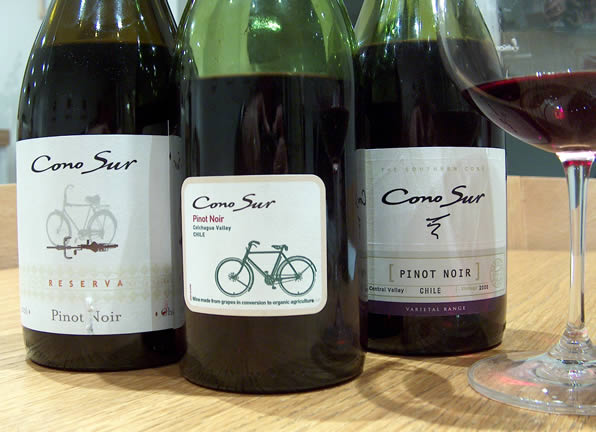|
Chilean
Pinot Noir from Cono
Sur

Adolfo
Hurtado is obviously keen on Pinot Noir: heís just planted a 40
hectare vineyard 10 km from the Pacific in San Antonio, called
Campolindo, which will come on line in 2009. Indeed, because vineyards
are large in Chile, Cono Sur are already one of the globeís largest
Pinot Noir producers as it is a grape theyíve focused on
extensively.
In
previous vintages I have taken a bit of a shine to Cono Surís basic
Pinot Noir. From the Cono Sur varietal range, it retails at around £5,
and I reckon that itís probably the worldís best value Pinot.
Remember, this is a grape thatís tricky to manage and which rarely
performs to its potential, with the result that most cheap Pinots are
a disaster. While the Cono Sur cheapie is no Romanťe-Conti, itís a
very respectable red that tastes of the grape it came from.
To
get an idea for how Hurtadoís Pinots are doing, I tasted three
current releases, all from the 2006 vintage. None are expensive; two
are widely available; and one is from a vineyard in conversion to
organics.
My
conclusions? These are nice wines that offer good value for money.
Itís inevitable that Pinot Noir gets compared to red Burgundy, and
this is probably missing the point: we should assess these wines in
their own right. Does Chilean Pinot Noir have its own voice? Itís
too soon to say, but after tasting a number of them I reckon there are
some recurring themes, most notably the coupling of ripe, sweet
cherry/berry fruit with a green herbal character, which only the best
examples seem to master sufficiently.
Itís
my impression that Hurtadoís Pinots are heading in the right
direction, although there is some way to go. These are impressive
wines considering the price pointsóletís face it, new world
competitors such as Central Otago Pinot Noir only really start
delivering north of £12óbut Iíd like to see perhaps just a little
less of the green herbal characters, which would make the wines a bit
more elegant, together with maybe a touch less alcohol. The fact that
the 'conversion to organic' wine is the best perfomer here suggests
that the route to this goal will be more work in the vineyard. Still,
I expect these commercially astute wines to be very successful in the
UK marketplace even as they show today.
An
intriguing question remains. Can Chile produce a world class Pinot
Noir? It may have already happened, of course, without me having tried
it. My view? It all depends on the vineyard. We'll see.
Cono
Sur Pinot Noir 2006 Colchagua
Fruit
sourced from Chimbarongo Estate, a vineyard that sees foggy mornings,
sunny days and cool nights, and which has alluvial and gravelly soils.
Harvested on 21 March 1996 at a generous yield of 10 tons/hectare.
Vines are vertically trellised and have drip irrigation, with
integrated management. The grapes are destemmed, macerated cold for 4
days and fermented in stainless steel. Aged in steel tanks with
innerstaves. The nose shows bright cherry and berry fruit with a
subtle herbiness. The palate is fruit driven and quite robust, with
some herby, spicy elements and some grippy tannins on the finish. Nice
freshness and fruit here. Itís not elegant, but it is vibrant and
food friendly, and tastes like Pinot Noir. Could be chilled. 14%
alcohol; screwcapped. Very good 85/100 (widely available)
Cono
Sur Pinot Noir Reserva 2006 Casablanca
Sourced from El Marco, Santa Isabel and Emiliana Estates in cool climate
Casablanca, which has foggy mornings, sunny days and cool nights.
Sandy soils with clay, harvested 28 March, at yields of 8
tons/hectare. Vertical trellis, drip irrigation and integrated
management. Destemmed and given cold maceration, fermented in
stainless steel, 90% matured in French oak barrels for 10 months. This
has quite a pure, deep, sweetly fruited nose showing cherry and berry
fruit with a bit of warm spice. The palate is dominated by sweet berry
fruits with plenty of presence, a hint of vanilla spice and some
tannic grip. Finishes herby and sappy. Thereís some elegance and
purity here, although the slightly green finish clamps down on this a
bit. Food friendly and potentially ageable for a few years, this is
good value and is moving in the right sort of direction. 14% alcohol;
screwcapped. Very good+ 87/100
(£6.99 Tesco, Somerfield)
Cono
Sur Pinot Noir Organic in Transition 2006 Colchagua
From the Santa Elisa Estate, with alluvial and gravelly soils. Harvested
20 March at 6 tons/hectare. Organic management and the use of
practices to increase natural enemies. Destemmed, cold maceration for
4 days, fermented in stainless steel and barrel matured (50% new
French oak, 50% second use). This has a lovely sweet, pure nose of
raspberries and cherries, with some sweet spice and a hint of
earthiness. The palate is quite robust and spicy with vibrant, juicy
cherryish fruit and warm, earthy, spicy structure. Thereís a bit of
herby greenness on the finish which shortens it a little, but overall
this is a delicious, ripe, nicely proportioned Pinot Noir in a full
flavoured style. Food friendly. Very good+ 88/100 (£6.99, no
off-trade listings yet)
Wines tasted 05/07
Find
these wines with wine-searcher.com
Back to top
|

